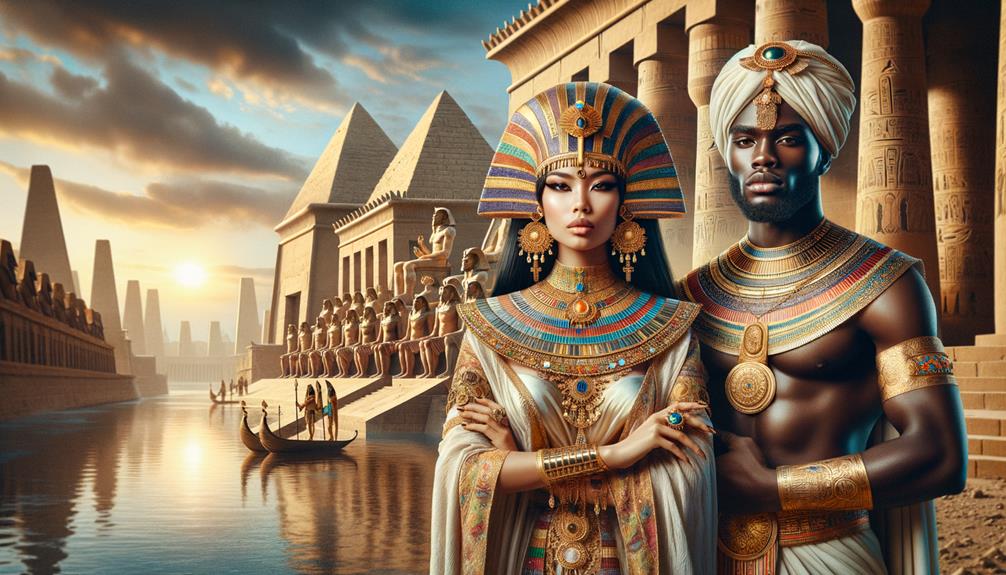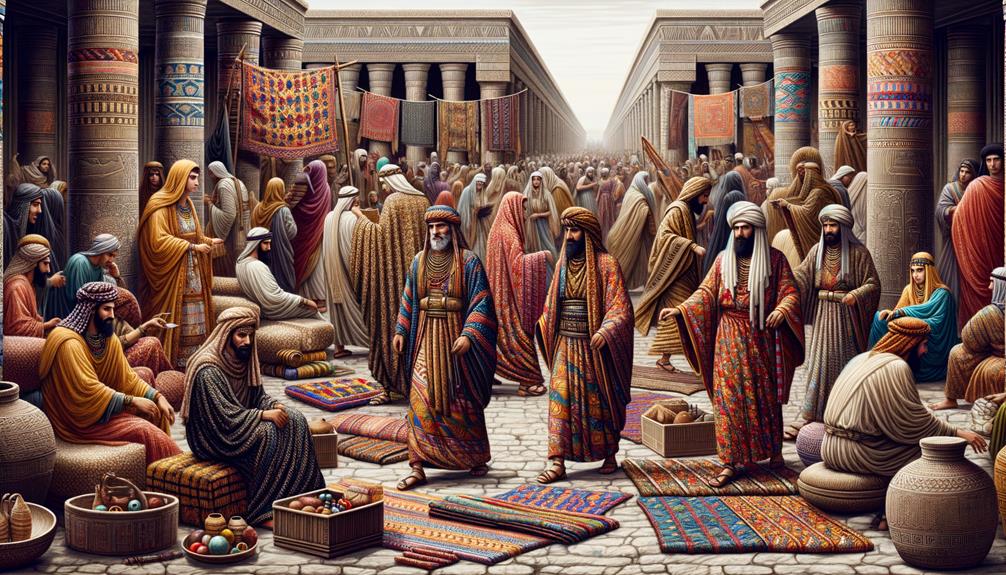Etruscan clothing is a testament to the civilization's love of luxury. The intricate fusion of Greek, Mesopotamian, and Asian influences in their attire is particularly fascinating. The fabrics and jewelry they used speak volumes about their social hierarchy and aesthetic values. For instance, women's garments made of wool, linen, and silk, adorned with intricate motifs, convey their social status and taste. In contrast, men's short tunics paired with pointed shoes present a striking, yet harmonious, contrast. Observing their religious attire and hairstyles reveals even deeper layers of cultural significance. What's truly captivating is how these elements come together to create a rich tapestry of tradition and innovation.
Origins and Development
Etruscan clothing, a blend of Eastern and Western influences, emerged in central Italy around 800 BC. The cultural fusion resulted from interactions with Greek, Mesopotamian, and Asian civilizations. This eclectic mix is reflected in the rich, colorful, and intricately designed garments depicted in the frescoes of the Tomb of the Lionesses.
The Etruscans' pointed shoes, made from supple leather, were not only functional but also a statement of style and social status. These shoes demonstrate the Etruscans' attention to detail and their ability to combine practicality with elegance.
As I delve deeper, I notice that Etruscan clothing styles didn't remain confined to their territory. They significantly influenced Roman attire, with the toga being a notable example derived from Etruscan traditions. The evolution of Etruscan fashion offers a fascinating glimpse into how cultural exchanges shape and refine sartorial expressions. By 80 BC, however, Roman dominance had largely erased these once-thriving Etruscan customs.
Women's Attire
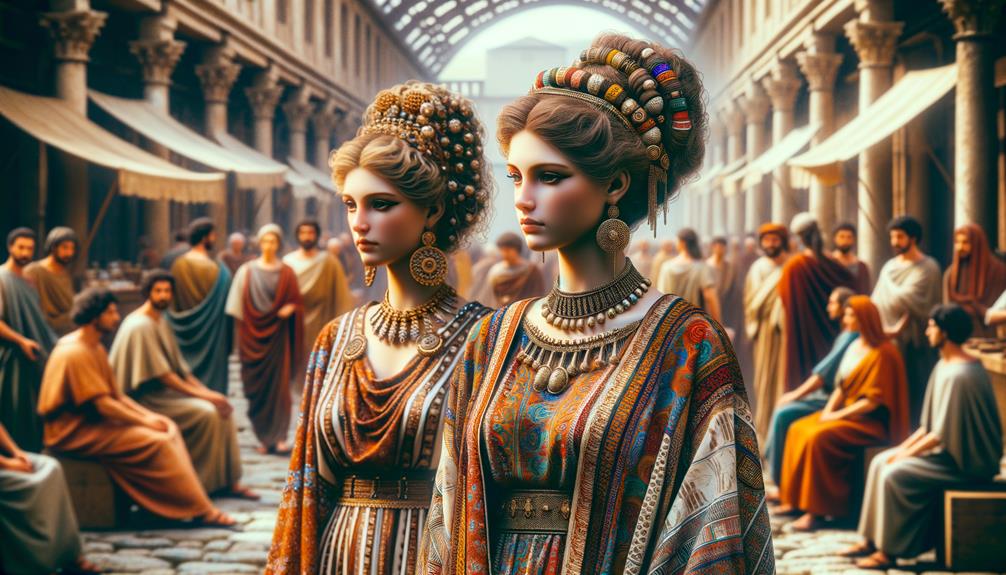
In examining the attire of Etruscan women, I notice the luxurious fabrics and intricate designs they favored, which distinguished them in the ancient world. Their jewelry and accessories were equally ornate, reflecting both personal status and cultural influences. Hairstyles and makeup further enhanced their appearance, completing an ensemble that was both refined and expressive.
Fabrics and Materials
When looking at the fabrics and materials used in ancient women's clothing, it's clear that wool, linen, and silk were the predominant choices. Each of these materials contributed to the vibrant colors and intricate decorations that defined Etruscan fashion.
Wool was a versatile fabric that Etruscan women favored, often weaving it into dresses that showcased a range of vivid hues like red, royal blue, and yellow. These colors weren't just for show; they underscored the cultural importance of visual appeal in Etruscan society.
Linen played a dual role, serving not only as a material for clothing but also in bookmaking, highlighting its significance beyond mere attire. The smooth texture of linen provided a pleasant contrast to the coarser feel of wool, allowing for varied tactile experiences in Etruscan fashion.
Although less common, silk added a touch of luxury to Etruscan women's clothing. Its delicate sheen and fine threads made it a prized material for those who could afford it. The garments often featured an assortment of decorative fringes and tassels, which enhanced their visual complexity. Sleeve lengths and hemlines varied, further showcasing the intricate decorative motifs that defined their clothing.
Jewelry and Accessories
Etruscan women transformed everyday garments into masterpieces by embellishing them with exquisite jewelry and accessories. Their jewelry, crafted from gold, silver, amber, ivory, and precious stones, showcased remarkable artistry. They adorned themselves with intricately designed gold necklaces, earrings, and bracelets that reflected their culture's sophistication.
Accessories played a vital role in elevating their attire. Elaborate tiaras, pins, dress clasps, and rings were not just functional but also statements of elegance and prestige. Earrings with pendants and necklaces with medallions added layers of visual interest and complexity to their outfits. The detailed designs featured embossing, engraving, and enamel artistry, highlighting the innovative spirit of Etruscan craftsmanship.
Observing these women, it's clear that jewelry and accessories were integral to their daily lives. Each ornament demonstrated their culture's ability to blend utility with aesthetic appeal, making their attire more than just clothing – it was an art form in itself. Through their distinctive jewelry and accessories, Etruscan women created wearable art that showcased their unique culture and style.
Hairstyles and Makeup
Etruscan women's hairstyles were a testament to their sophistication, ranging from intricate braids to Greek-inspired arrangements that conveyed social status and cultural nuances. Elaborate braids were favored in early generations, eventually giving way to Greek fashion as cultural exchanges intensified. Adorned with ribbons, bands, and decorative pins, their hairstyles added layers of visual complexity, signifying their place in society.
Makeup played a significant role in their daily lives, used to accentuate their features, particularly their eyes and lips. This practice wasn't just about vanity; it reflected their societal roles and personal identities. The interplay between hairstyles and makeup created a palette of elegance and poise, showcasing the Etruscan commitment to personal presentation.
Hair accessories served a dual purpose, not only ornamental but also functional, helping to maintain these intricate styles throughout daily activities. Observing these choices reveals a culture deeply invested in the art of self-expression. Through their hairstyles and makeup, Etruscan women crafted a visual language that communicated beauty, status, and cultural alignment, leaving a lasting impression on those who studied their artifacts.
Men's Attire
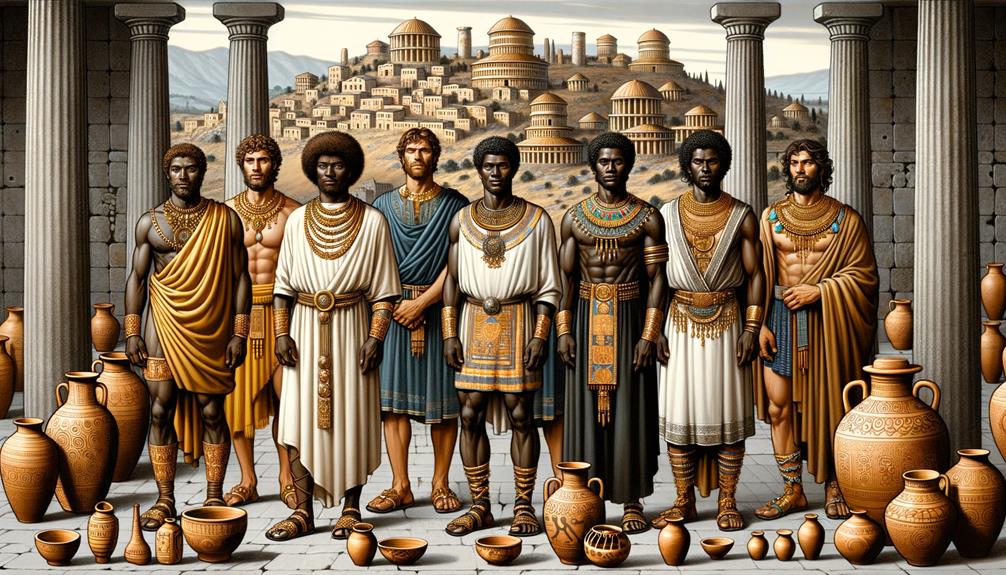
Men's attire in ancient Etruscan society was a perfect blend of style and practicality. Etruscan men typically wore short tunics or jerkins, often secured with belts, which reflected their down-to-earth approach to fashion. These tunics, sometimes colorful and embroidered, offered a glimpse into their rich textile traditions.
Their footwear was equally distinctive, with pointed shoes influenced by Ionian and Near Eastern styles. These shoes, with their sharp tips, highlighted the Etruscans' inclination towards unique and sophisticated designs. The daily attire of Etruscan men was not only a statement of fashion but also functioned to signify their social and cultural identity.
Here's an overview of the key elements in Etruscan men's attire:
| Element | Description | Influence/Significance |
|---|---|---|
| Short Tunics | Everyday wear, often belted | Practical and stylish |
| Pointed Shoes | Distinct footwear with sharp tips | Influenced by Ionian and Near Eastern styles |
| Trebenna | Early version of the Roman toga | Cultural influence on Roman attire |
| Priest Garments | Sheepskin worn inside out | Unique to religious roles |
| Embroidered Cloaks | Worn by magistrates like Vel Saties | Signified status and authority |
Through their clothing choices, Etruscan men not only adhered to their cultural norms but also subtly influenced the broader Mediterranean fashion landscape.
Jewelry and Accessories
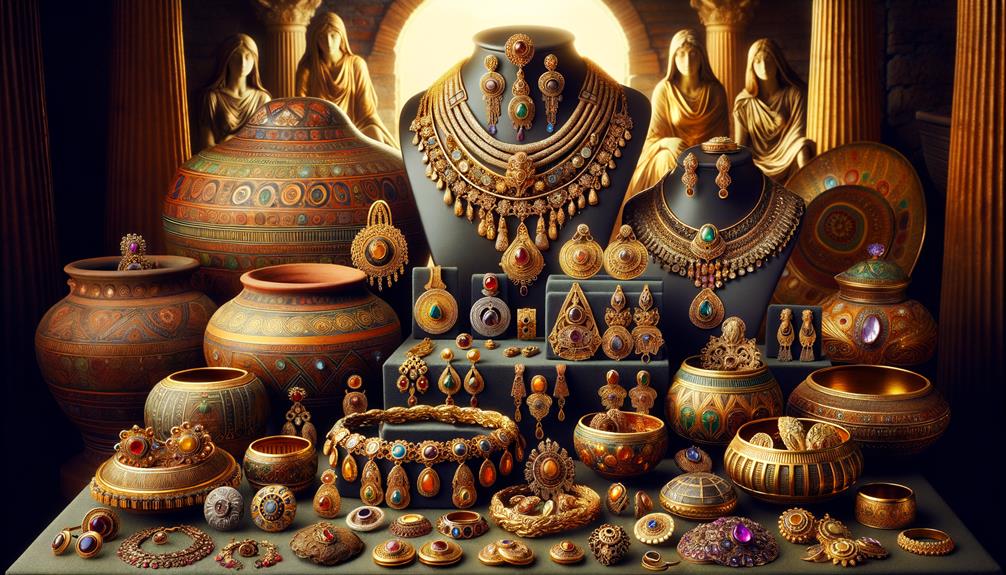
While Etruscan men demonstrated their elegance through practical clothing, their love for intricate jewelry and accessories revealed a deeper layer of sophistication. The Etruscans, both men and women, adorned themselves with a variety of finely crafted items, each piece reflecting their skill and aesthetic sensibility.
Earrings, often featuring elaborate pendants, were a staple in women's fashion, adding a touch of luxury to their attire. Men, on the other hand, favored chains with medallions, showcasing their status and taste. Necklaces, crafted from gold, silver, and precious stones, displayed a range of designs from simple chains to complex, multi-strand creations.
The Etruscans didn't stop at jewelry; accessories like dress clasps and brooches also played a significant role in their fashion. Tiaras, often found in archaeological discoveries, were not merely symbols of royalty but also expressions of artistry, adorned with intricate embossing and enamel work. Rings and pins further emphasized the Etruscans' attention to detail and their innovative spirit in personal adornment.
Observing these artifacts, one can't help but appreciate the Etruscans' ability to blend functionality with intricate beauty, creating a culture where every accessory told a story of elegance and innovation.
Religious Garments
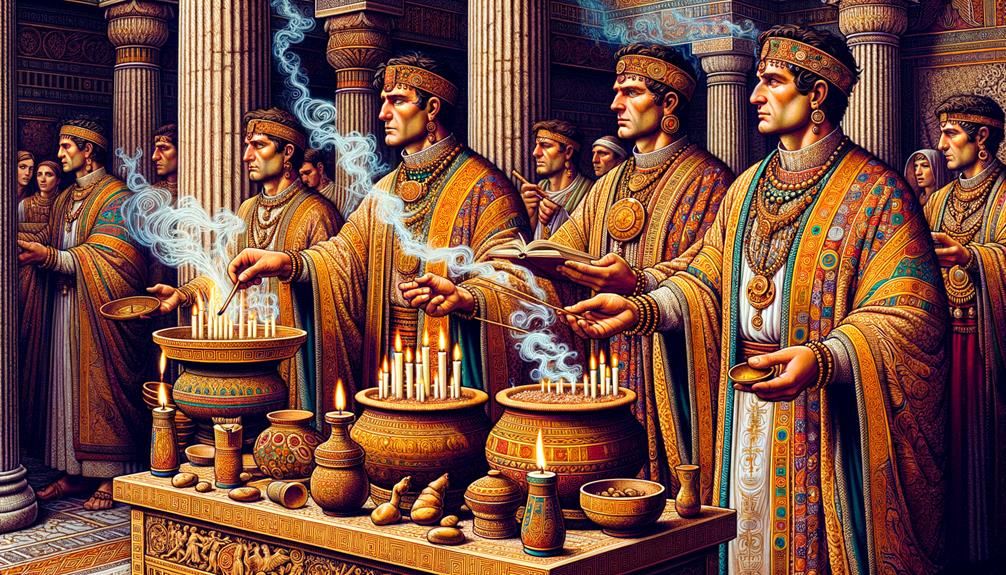
In religious ceremonies, priests wore distinctive white woolen tunics paired with blue capes adorned with stripes, blending native tradition with external influences. Women in religious roles donned one-cut shirts, capes, and bodices, often embellished with symbolic decorations. These garments played a vital role in sacred rituals, signifying spiritual significance.
The intricate details and symbolic elements depicted in Etruscan wall paintings and tomb frescoes offer a vivid glimpse into the ceremonial attire. Every piece, from veils to headdresses, had its place and purpose, seamlessly integrating native traditions with influences from Greece and the Near East.
Here is a visual representation of these ideas:
| Garment Type | Description | Cultural Influence |
|---|---|---|
| Tunics and Capes | White woolen tunics, blue capes with stripes | Native and Greek/Near East |
| One-Cut Shirts | Symbolically decorated, worn by women | Native traditions |
| Veils and Headdresses | Signified spiritual significance in rituals | Native and external |
Etruscan religious clothing, as showcased in their tombs and wall paintings, highlighted the blend of cultural influences, underscoring the garments' spiritual and ceremonial importance.
Hairstyles and Headdresses
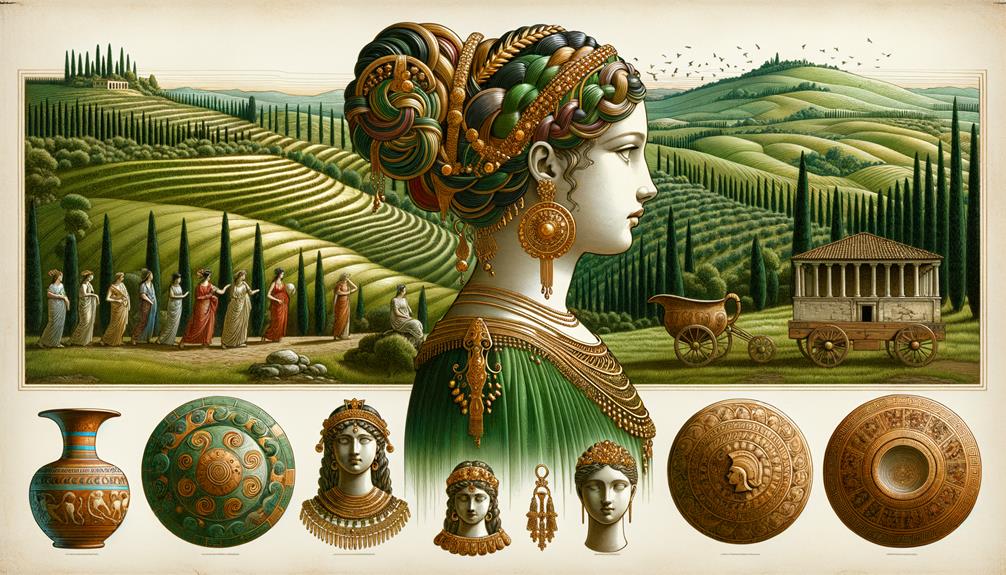
Hairstyles and Headdresses
Etruscan identity wasn't just about religious garments; hairstyles and headdresses played a significant role in showcasing cultural and social nuances. The Etruscans had a wide range of hairstyles, from shaved heads to intricately styled small curls. This diversity in grooming practices among men and women reflects the richness of Etruscan culture.
Their headdresses were equally varied, drawing inspiration from Assyrian, Persian, Egyptian, and Greek civilizations. This cultural exchange is a testament to the Etruscans' openness to external influences. Women adorned their hairstyles with intricate braids and accessories, demonstrating a keen sense of aesthetics. These adornments weren't just decorations; they symbolized status and identity.
Men often wore tutulus hats, adding a distinctive touch to their ensemble and highlighting their roles in society. These headdresses weren't just functional; they represented an individual's position within the social hierarchy.
- Shaved heads and small curls: Examples of diverse Etruscan grooming practices.
- Tutulus hats: Worn by men, signifying status and role.
- Intricate braids and accessories: Adorning women's hairstyles, showcasing cultural values.
The variety in Etruscan hairstyles and headdresses reflects the cultural dynamism and external influences that shaped their identity.
Footwear Styles
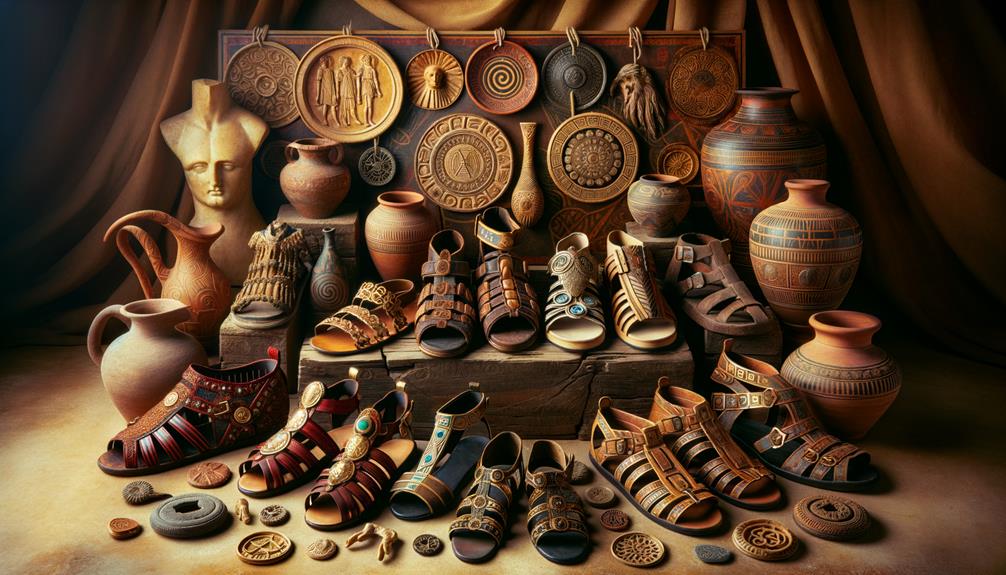
When I look at Etruscan footwear, I notice a remarkable blend of practicality and status. Leather sandals, often designed with narrow straps, served as both functional attire and symbols of social standing. The intricacies of these designs reveal a culture where fashion and function blended seamlessly together.
Leather Sandals Design
Etruscan leather sandals, with their sturdy soles and minimalist designs, showcase the culture's perfect blend of practicality and subtle elegance. These sandals were a staple in Etruscan clothing, providing both men and women with footwear that prioritized function and comfort. Crafted from local materials using time-honored techniques, these sandals demonstrate an impressive balance between durability and aesthetic appeal.
Decorative elements were not absent from these practical designs. Straps, intricate stitching, and stylish buckles added a touch of flair without compromising functionality. This combination of practicality and subtle embellishments reflects the Etruscan approach to everyday attire, where even the most utilitarian items bore an element of thoughtful design.
Robust Construction: The use of high-quality local leather ensured longevity and resilience.
Simple Aesthetic: Simple yet effective designs catered to the everyday needs of the Etruscan people.
Subtle Beauty: Decorative elements like buckles and stitching provided understated beauty.
Observing these sandals, one can appreciate the Etruscan ability to seamlessly merge practicality with decorative elements. This footwear style is a testament to the culture's innovative spirit, marrying form and function in a way that remains intriguing to this day.
Status Symbol Footwear
Pointed shoes, often vibrantly colored and intricately designed, held significant social status among the Etruscans, blending influences from Ionia and the Near East into their unique fashion style. Both men and women wore these shoes, with long pointed toes being a hallmark of their design. In tombs like the Tomb of the Augurs, we find exquisite examples in hues of green, red, and burgundy, each color carefully chosen to reflect the wearer's rank and regional identity.
The Etruscans' footwear styles showcased impressive diversity, surpassing that of their Greek counterparts. The long pointed shoes featured slightly raised points at the toes and widened fronts, a design choice that was both practical and aesthetically pleasing. These elements made the footwear distinctly Etruscan, showcasing their innovative spirit and cultural fusion.
Practicality and Functionality
While vibrant Etruscan footwear designs conveyed social status, their practicality and functionality underscored the complexities of daily life. Etruscan men and women navigated diverse terrains and climates, requiring footwear that balanced aesthetic appeal with utilitarian needs.
Etruscan men typically wore shoes with narrow straps and pointed toes, a design that likely facilitated ease of movement and aligned with contemporary fashion trends. Women, on the other hand, favored footwear with longer toes and decorative elements, reflecting their societal roles and preferences for adornment. The distinct differences in design between men's and women's shoes reveal a nuanced approach to functionality, influenced by gender-specific activities and status.
Climate played a significant role in Etruscan footwear design, with variations accommodating regional climates to ensure comfort and durability. Advances in crafting techniques and materials also influenced footwear styles over time. Furthermore, footwear remained a marker of social hierarchy, highlighting the interplay between practicality and design.
Etruscan frescoes provide a vivid record of these styles, illustrating the diversity and evolution of Etruscan footwear over time. This interplay between practicality and design in these shoes offers a unique window into the daily lives and sophisticated culture of the Etruscans.
Cultural Influences
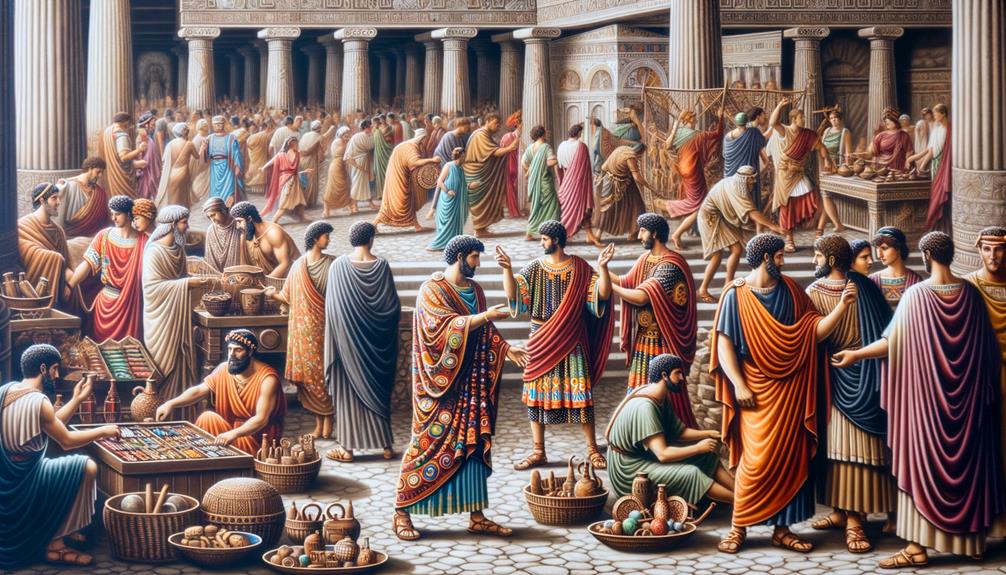
The Etruscan culture was shaped by numerous external influences, blending elements from Greek, Mesopotamian, and Asian civilizations into their artistic and fashion traditions. For centuries, the Etruscans drew inspiration from Greek city-states, adopting and adapting their vibrant cultural aspects. This exchange had a lasting impact, evident in their intricate designs and garments, such as the tebenna cloak, which greatly influenced Roman attire.
A closer look at Etruscan art reveals a refined blend of external styles. Greek motifs were incorporated into their pottery and jewelry, while Mesopotamian influences added depth and complexity to their iconography. Asian elements contributed to their ornate textiles and patterns, reflecting a cross-cultural dialogue that defined their aesthetic.
Frequently Asked Questions
What Did the Etruscans Wear?
Etruscans wore vibrant dresses and short tunics, influenced by Eastern styles, and added pointed shoes to their outfits. Priests took a different approach, wearing sheepskins inside out over their tunics. They also introduced the toga, a symbol that would later be adopted by the Romans.
What Was the Etruscan Culture?
Exploring Etruscan culture reveals a society shaped by Greek, Mesopotamian, and Asian influences. Their advanced city-states flourished with vibrant art, intricate goldwork, and elaborate tombs, until the Roman conquest led to cultural eradication.
What Is Etruscan Style?
Etruscan style is characterized by its bold use of colors like red and royal blue. The fashion of the time featured men wearing short tunics, while women wore a variety of dresses with intricate patterns and pointed shoes. They also introduced the toga, which was later adopted by the Romans.
What Are the Characteristics of an Etruscan Costume That Appear to Be Unique or Distinctive?
Etruscan costumes are a vibrant testament to the civilization's rich cultural heritage. The intricate embroidery and pointed footwear are distinctive features of their attire. Men's elegant cloaks and women's billowing sleeves reflect the blend of Ionian and Near Eastern influences that shaped their unique style.



